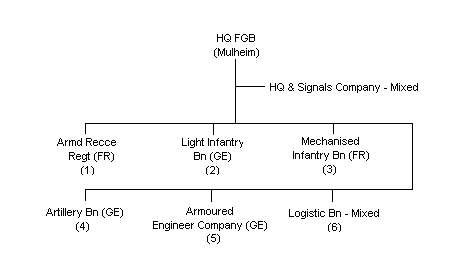The Eurocorps was created in 1992 and comprises military contributions from its
five framework nations: Belgium, France, Germany, Luxembourg and
Spain. The Headquarters is located in Strasbourg (France). Austria,
Canada, Greece, Italy, Poland and Turkey have military liaison staff
co-located at Eurocorps HQ
The Commander Eurocorps (COMEC) is a Lieutenant
General (3 stars). The Deputy Commander (DCOM) is a Major General (2
stars). The staff is directed by the Chief of Staff (COS), also a
Major General and he is supported by two Deputy Chiefs of Staff (DCOS)
for Operations and Support, both of whom are Brigadier Generals (1
star).
The posts of Commanding General and the other general officers as
well as some key functions are filled by EU framework nations on a
rotational basis. COMEC, DCOM and COS are always of different
nationalities. Their tour of duty generally lasts for two years. In
general terms the Eurocorps is at the disposal of the European Union
and available for service in support of NATO. The command language
is English.
The Eurocorps consists of formations under direct operational
control and formations earmarked for assignment during a crisis or
emergency:
Under direct operational control:
Formations earmarked for assignment during an
emergency:
French Contribution
Etat-Major de Force numéro 3 (EMF3) in
Marseille (equivalent to a
Divisional
HQ) composed of:
|
1
x Armoured Brigade
1 x Mechanised Infantry Brigade
Specialised Support Units |
German
Contribution
The 10th Armoured Division, with its HQ in
Sigmaringen, composed of:
|
2 x Brigades as
required
Specialised Support Units |
|
Belgian
Contribution
Belgian Operational Command Land, with its HQ in
Evere, composed of:
|
1st Mechanised Brigade in Leopoldsburg
7th Mechanised Brigade in Marche-en-Fammene
Support Units |
Spanish Contribution
1st Land Forces Command its HQ in Burgos, composed
of:
|
10th Mechanised Brigade in Cordoba
11th Mechanised Brigade in Badajoz
12th Armoured Brigade in Madrid |
Luxembourg
Contribution
Luxembourg assigns a reconnaissance company composed
of about 180 personnel. During operations this unit would be
integrated into the Belgian contingent. During the past decade the
Eurocorps has been involved in operations as follows:
Note: If all earmarked national contributions were
committed to operations, the Eurocorps would number approximately
60,000 personnel.
Franco - German Brigade (FGB)
This is a joint formation which consists of both
French and German units and under the direct command of the
Eurocorps. The Eurocorps was inaugurated in January 1989 and
declared operational in October 1991.
The FGB is essentially a wheeled mechanised Brigade.
It is the core entry group for Eurocorps operations and in concert
with the EU Battlegroups the immediate EU reserve formation.
FRANCO GERMAN
BRIGADE
Approximately 5,200
personnel
Notes:
(1) 3e Regiment de Hussars
(2) Jagerbataillon 292
(3) 110e Regiment d’Infanterie
(4) Panzerartilleriebataillon 295
(5) Panzerpionierkompanie 500
(6) Logistic Battalion with: Supply Company; Maintenance Company;
Transport Company; Administration & Support Company; HQ & Support
Company.
EU BATTLEGROUPS
In the immediate future, the EU plans to be able to provide at least
one coherent Battlegroup package at any one time (usually two), to
undertake Battlegroup-sized operations in support of the EU Helsinki
Headline Goals.
Full Operational Capability (FOC) was reached at the end of 2007
when all Battlegroups became available. The EU now has the capacity
to undertake at least two concurrent single Battlegroup-size rapid
response operations, including the ability to launch both such
operations nearly simultaneously.
EU Member States have indicated that they will commit to Battle
Groups, formed as follows:
|
1 |
United Kingdom |
|
2 |
France |
|
3 |
France and Belgium |
|
4 |
Italy |
|
5 |
Spain |
|
6 |
France, Germany, Belgium, Luxembourg and
Spain |
|
7 |
Germany, the Netherlands and Finland (BG
107) |
|
8 |
Germany, Austria and Czech Republic |
|
9 |
Italy, Hungary and Slovenia |
|
10 |
Spain and Italy (Amphibious) |
|
11 |
Italy, Romania and Turkey |
|
12 |
Poland, Germany, Slovakia, Latvia and
Lithuania |
|
13 |
Sweden, Finland, Estonia, Ireland and
Norway |
|
14 |
United Kingdom and the Netherlands |
|
15 |
Greece, Bulgaria, Cyprus, Romania and
Slovenia |
|
16 |
Czech Republick and Slovakia |
|
17 |
Spain, Germany, France and Portugal |
|
|
|
|
Expect a battle group to have between
1,500 and 2,000 personnel. |
There are usually 2 x
EU Battlegroups on standby for operations and trained to respond to
emerging contingencies at any one time. They would be deployed
following a unanimous decision of the European Council of Ministers,
with the nations providing the Battlegroup having a veto on any
deployment decision.
Each Battlegroup will have a 'lead nation' that will take
operational command, based on the model set up during the EU's
peacekeeping mission in the Democratic Republic of the Congo
(Operation Artemis). Two non-EU NATO countries, Norway and Turkey
participate in the EU Battlegroup program.
Battlegroups would have to be able to deploy within 5-10 days and be
sustained initially for 30, but possibly up to 120 days while
operating up to 6,000 km from Brussels.
EUROPEAN RAPID REACTION FORCE
As yet (mid 2010) there is no standing European Rapid Reaction Force
(other than the Franco – German Brigade) nor any EU agreement to
create one. What has sometimes been referred to as a ‘European Rapid
Reaction Force’ is, in fact, a catalogue of forces which member
states could make available to the EU should they choose to
participate in a particular EU-led operation.
Any contribution to a particular EU-led operation would depend on
the operation's requirements, the availability of forces at the time
and the willingness of EU members to participate. However, it is
likely that this will change during the next five years.

